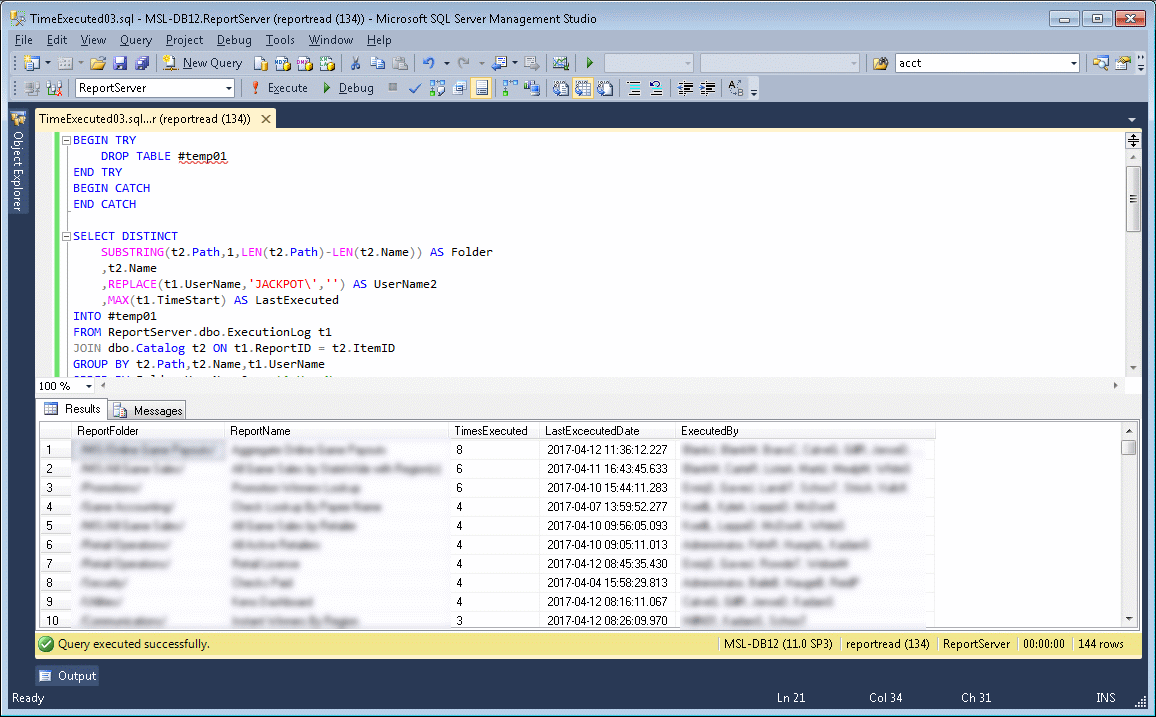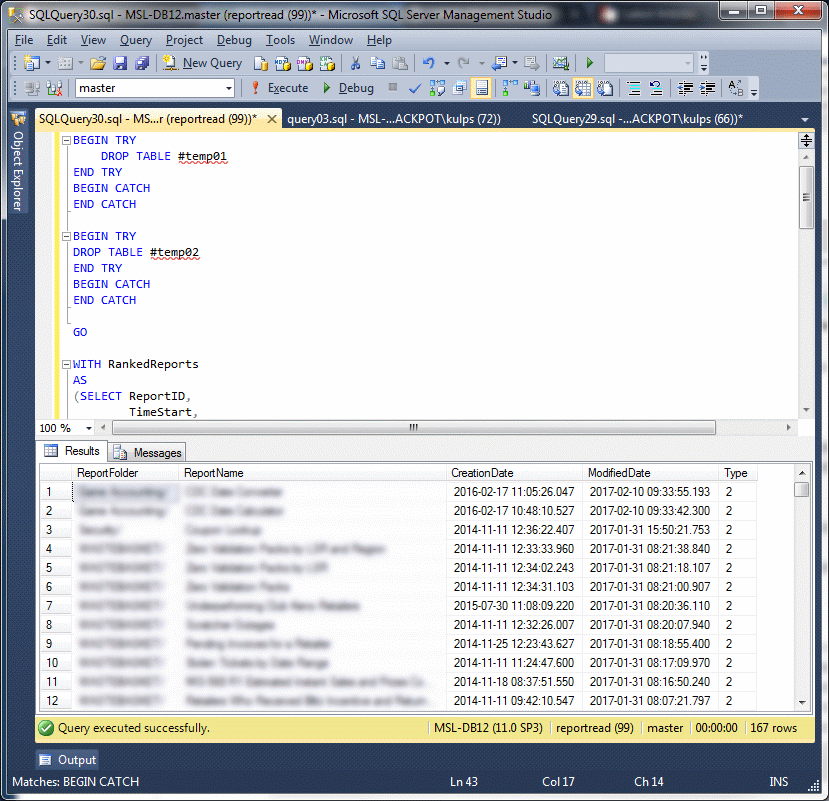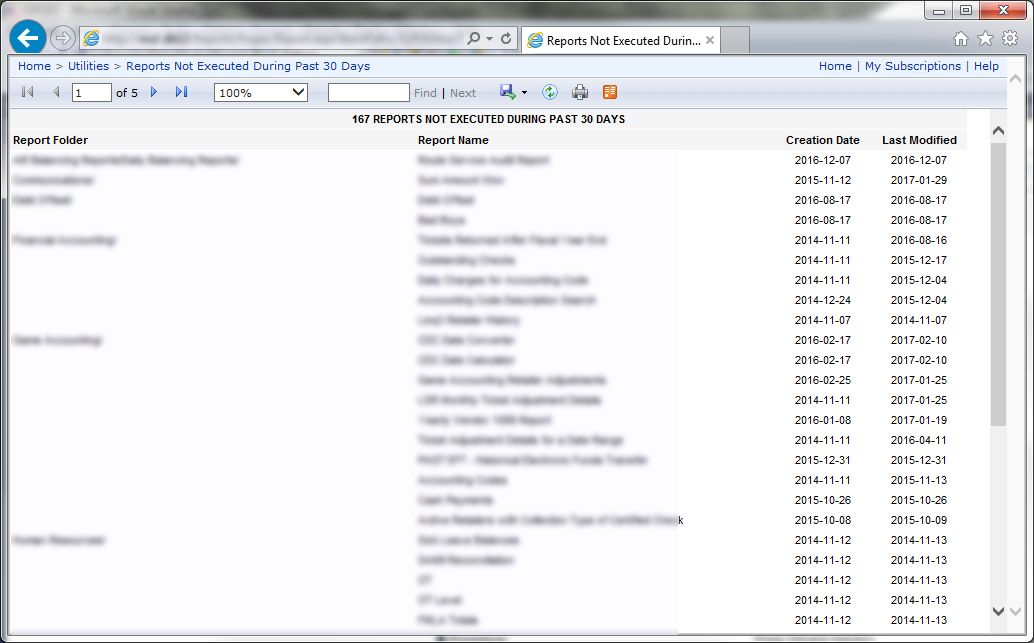Microsoft does not document or support querying the ReportServer database, but it contans a lot of useful information about SSRS reports. A previous article, Dynamic SSRS report documentation via a ReportServer.dbo.Catalog query, demonstrated how to query the ReportServer.dbo.Catalog to generate live documentation of SSRS reports.
In this article we will query the ReportServer.dbo.ExecutionLog table to determine which reports have been executed in the past month and which have not.
By default, SQL Server only stores 30 days of data in the ReportServer.dbo.ExecutionLog table. For more information on how to configure execution logging see How to Audit Report Execution in SSRS by Peter Avila.
Reports Executed During Past 30 Days
Paste the following query of the ReportServer.dbo.ExecutionLog into a SQL Server Managment Studio query panel...
BEGIN TRY DROP TABLE #temp01 END TRY BEGIN CATCH END CATCH SELECT DISTINCT SUBSTRING(t2.Path,1,LEN(t2.Path)-LEN(t2.Name)) AS Folder ,t2.Name ,REPLACE(t1.UserName,'JACKPOT\','') AS UserName2 ,MAX(t1.TimeStart) AS LastExecuted INTO #temp01 FROM ReportServer.dbo.ExecutionLog t1 JOIN ReportServer.dbo.Catalog t2 ON t1.ReportID = t2.ItemID GROUP BY t2.Path,t2.Name,t1.UserName ORDER BY Folder,UserName2 --,t1.UserName SELECT DISTINCT Folder AS ReportFolder ,Name AS ReportName ,COUNT(Name) AS TimesExecuted ,MAX(LastExecuted) AS LastExcecutedDate ,ExecutedBy = STUFF(( SELECT ', ' + UserName2 FROM #temp01 WHERE Name = x.[Name] FOR XML PATH(''), TYPE).value('.[1]', 'nvarchar(max)'), 1, 2, '') FROM #temp01 x WHERE Name <> '' GROUP BY Folder,Name ORDER BY TimesExecuted DESC,ReportFolder,Name
...and execute it. The query returns all the reports that have been executed during the past 30 days, how many times they were executed, and who ran them.

Download the attached Reports Executed During Past 30 Days.rdl file, open it in development studio, add credentials for a user with permission to read the ReportServer database and run it.

Reports Not Executed During Past 30 Days
Paste the following query of the ReportServer.dbo.ExecutionLog into a SQL Server Managment Studio query panel...
BEGIN TRY DROP TABLE #temp01 END TRY BEGIN CATCH END CATCH BEGIN TRY DROP TABLE #temp02 END TRY BEGIN CATCH END CATCH GO WITH RankedReports AS (SELECT ReportID, TimeStart, UserName, RANK() OVER (PARTITION BY ReportID ORDER BY TimeStart DESC) AS iRank FROM ReportServer.dbo.ExecutionLog t1 JOIN ReportServer.dbo.Catalog t2 ON t1.ReportID = t2.ItemID AND t2.Type <> 1 ) SELECT DISTINCT t1.UserName,t2.Name AS ReportName ,SUBSTRING(t2.Path,2,LEN(t2.Path)-LEN(t2.Name)-1) AS Folder,t2.Type INTO #temp01 FROM RankedReports t1 INNER JOIN ReportServer.dbo.Catalog t2 ON t1.ReportID = t2.ItemID WHERE t1.iRank = 1 AND t2.Type <> 1 ORDER BY t1.UserName,t2.Name; SELECT SUBSTRING(Path,2,LEN(Path)-LEN(Name)-1) AS ReportFolder ,Name AS ReportName ,CreationDate ,ModifiedDate ,Type INTO #temp02 FROM ReportServer.dbo.Catalog WHERE Name NOT IN (SELECT ReportName FROM #temp01) AND Path <> '' ORDER BY Path SELECT * FROM #temp02 WHERE ReportFolder <> '' AND Type = 2 ORDER BY ModifiedDate DESC
...and execute it. The query returns all the reports that have not been executed during the past 30 days.

Download the attached Reports Not Executed During Past 30 Days.rdl file, open it in development studio, add credentials for a user with permission to read the ReportServer database and run it.

Conclusion
This article has presented two reports that can be used to detect SSRS reports that are being used extensively and SSRS reports that are no longer being used at all.

